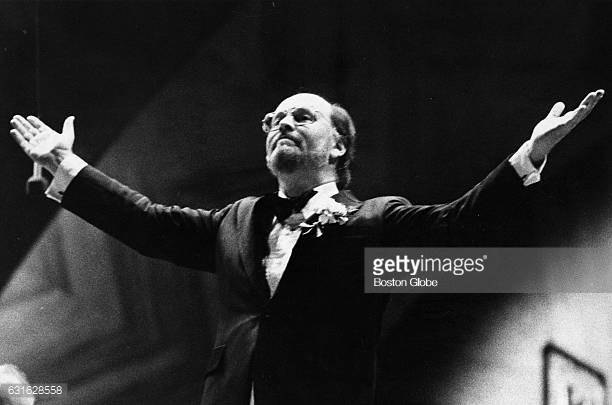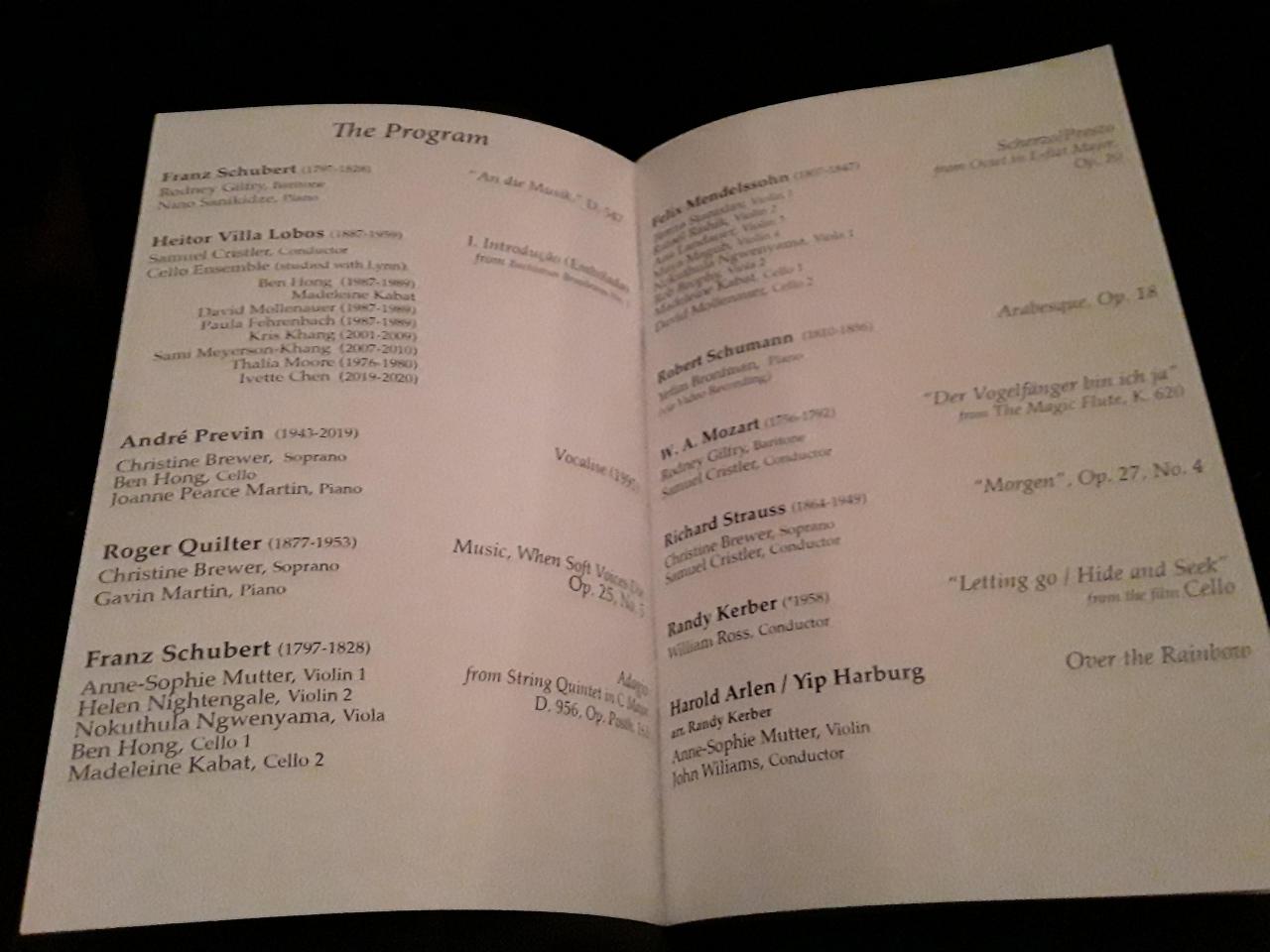-
Posts
4,765 -
Joined
-
Days Won
6
Everything posted by SteveMc
-

Which concert was better, Vienna or Berlin?
SteveMc replied to bollemanneke's topic in JOHN WILLIAMS
Yeah, we're all just glowing with excitement. Vienna was amazing too, and I think maybe their CE3K was better than Berlin's, but Berlin was just so passionate. Vienna had grandeur, Berlin felt like a night of vindication. -

John Williams & Berliner Philharmoniker 14th/15th/16th Oct 2021
SteveMc replied to MaxTheHouseelf's topic in JOHN WILLIAMS
Pretty epic. Would be nice if JW came back to mingle with the faithful -

John Williams & Berliner Philharmoniker 14th/15th/16th Oct 2021
SteveMc replied to MaxTheHouseelf's topic in JOHN WILLIAMS
Ah, that was very nice -

John Williams & Berliner Philharmoniker 14th/15th/16th Oct 2021
SteveMc replied to MaxTheHouseelf's topic in JOHN WILLIAMS
I think the city regs call for a particular mask type for these kinds of events. -
This is pretty neat. Malcom Arnold conducting. Not a bad piece.
-

The Definitive John Williams Plagiarism/Homage Thread
SteveMc replied to indy4's topic in JOHN WILLIAMS
Oooh, that is similar. -
My favorite cue from my favorite Goldsmith score
-
we still doing this?
-

The John Williams Concert Work Listening and Discussion Thread
SteveMc replied to SteveMc's topic in JOHN WILLIAMS
Summon The Heroes (1996) Williams returns to the subject of the Olympics for this overture written for the 1996 Atlanta Games. It opens with trumpets heralding the uncommon man (and woman) with a melodic contour that strongly brings to mind Copland. The melody then goes through a very Williams pastoral-heroic Americana treatment by solo trumpet, before the theatrics begin again with characteristic Williams flourishes in brass and strings, with a b-theme introduced. Similar to the theme for the 84 games, Williams brings in a passage of intricate anticipation that sets off a rousing restatement and climax. It's a pretty great work all around. -

The John Williams Concert Work Listening and Discussion Thread
SteveMc replied to SteveMc's topic in JOHN WILLIAMS
Bassoon Concerto The Five Sacred Trees(1995) Williams's Bassoon Concerto is a programmatic work in five movements originally written for the New York Philharmonic's bassoonist Judith LeClair. The programmatic intent of the work perhaps led Williams to choose a clearly lyrical and often quite consonant language for the concerto. While premiered in 1995 to mark the NY Phil's 100th anniversary, there is some copyright indication that the piece was completed in 1993. Williams provided names and program notes that tied each of the movements to mythological Celtic guardian trees themselves tied to certain tree varieties. The first movement, Eó Mugna, represents the oak as a source of mystical wisdom and a bridge to the spirit realm. The movement is perhaps the most sophisticated incarnation up to this point of Williams's preferred first movement approach. The opening consists of a long, lyrical cadenza for solo bassoon, with the orchestra joining in the lyrical motion with some shades of Ralph Vaughn Williams and Holst, building up to a very Williams resounding climax. This sets off a second cadenza, before the movement ends with a sort of mysterious, even vaguely threatening quiet conclusion. The second movement follows, entitles Tortan. This tree was an ash in legend, representing dark magic. Not surprisingly, Williams brings a solo violin to play the role of evil fiddle in a spooky yet sophisticated dance with the bassoon. Energetic bursts from the orchestra punctuate the proceedings. The third movement, Eó Rossa, feels a lot like 1993 Williams to me for some reason. This is a quiet movement, where lyricism is tinged with pain instead of romance. Williams noted that he sought to explore the intersection between death and rebirth that characterized the mythology around the movement's namesake mythological tree, a yew with life and death powers. The movement has a definite united beauty. The fourth movement, Craeb Uisnig, deals with a war-like ash. This movement is the most dissonant of the five. Yet, it has a drive that connects it with a lot of Williams's action and suspense writing, if perhaps a bit more creatively orchestrated. The fourth movement dissolves directly into the fifth, Dathi, which has a definite elegiac character. It seems to be the movement with the most dialogue and immediacy with the listener. Lyrical melody and dissonance blend in a resolute manner, and the overall structure calls to mind the first movement but with more finality and introspection. I can't help but hear elemental parallels to passages from works like the upcoming Elegy for Cello and Orchestra and Schindler's List and The Book Thief here. The movement and the work ends on a gentle passage of acceptance from the bassoon. Two major recordings of the piece are LeClair's with the London Symphony under Williams's direction from 1997 and, from 2015, Slatkin conducting Robert Williams and the Detroit Symphony. Here is LeClair's recording with sheet music of the bassoon part p.s. sorry for the long gap between posts. I'm going to try to prevent that from happening in the future. -

What Is The Last Score You Listened To? (older scores)
SteveMc replied to Ollie's topic in General Discussion
The Terminal Pretty charming. The shimmering cues are quite different from the the more folky, jazzy or broadly romantic ones. The contrast is nice, but it does make for a score that is not quite as unified as some others. The charming character provides most of the common thread in the score. -

John Williams to conduct in Remembrance of Lynn Harrell
SteveMc replied to BB-8's topic in JOHN WILLIAMS
So glad I was here! -

John Williams to conduct in Remembrance of Lynn Harrell
SteveMc replied to BB-8's topic in JOHN WILLIAMS
-

The John Williams Concert Work Listening and Discussion Thread
SteveMc replied to SteveMc's topic in JOHN WILLIAMS
Happy Birthday Variations (1995) So, a concert piece I had not heard before tonight. An interesting little orchestral jaunt through the famous birthday song. It was written as a birthday tribute to Seiji Ozawa, Yo-Yo Ma, Itzhak Perlman and Leon Fleischer. I kind of like it, manages to be both fun and challenging. Some discussion here: And here is a recording. -

The John Williams Concert Work Listening and Discussion Thread
SteveMc replied to SteveMc's topic in JOHN WILLIAMS
Satellite Celebration (Song For World Peace) 1995 Orchestral piece for orchestra, chorus and soloists originally written by Williams for an NHK New Year's broadcast to mark the coming of the year 1995. The piece was retitled and rearranged later for conventional orchestra forces. The original version was a bit ahead of its time, as many of the performers were in different locations, linked by satellite. The original piece is quite stately overall, with a kind of self-consciously classical nature coming through. I would definitely like to hear a studio recording. The revised "Song For World Peace" is a bit less unique, and really misses the choral parts. But it is still an enjoyable listen. Here is a rough recording of the original, conducting by Seiji Ozawa and featuring Yo Yo Ma and Itzhak Stern, and the revised version, from the American Journey disc. -

John Williams to conduct in Remembrance of Lynn Harrell
SteveMc replied to BB-8's topic in JOHN WILLIAMS
Seems I'm actually going in person! -

THE ADVENTURES OF HAN - 2018 John Williams theme for Solo: A Star Wars Story
SteveMc replied to Obi's topic in JOHN WILLIAMS
If I remember right it was lively enough, though probably not as fast as that clip. -

John Williams to conduct in Remembrance of Lynn Harrell
SteveMc replied to BB-8's topic in JOHN WILLIAMS
Is the student price only for current UCLA students or for students in general? -

The John Williams Concert Work Listening and Discussion Thread
SteveMc replied to SteveMc's topic in JOHN WILLIAMS
Cello Concerto (1994) The Cello Concerto, a post-romantic work in four movements, was written by John Williams for the world renowned Yo Yo Ma at the suggestion of Boston Symphony conductor Seiji Ozawa. It is a generally bright and accessible work that definitely feels like an event. It was written to showcase the Ma's talent and the public's appreciation for his craft. As such, it seldom drifts into too heavy territory, instead inviting the audience to join the soloist and orchestra on a journey through musical moods that, while not quite completely in the style of Williams's film music, evoke a certain familiar response. Williams gave program notes for each of the movements, which can be found in full here: https://www.hollywoodbowl.com/musicdb/pieces/1338/concerto-for-cello-and-orchestra The first movement, Theme and Cadenza sets out right away "immediately casts the cello in a kind of hero’s role, making it the unquestioned center of attention. It’s a movement that attempts to put the cello on display in the time-honored sense of 'concerto,'" in Williams's words. The central theme is most prominent as the cello and orchestra builds up to a couple of of flourishing climaxes that segue into the extended cadenza. The main theme returns before the soft ending. Flowing directly, the second movement Blues is perhaps the most modernist segment of the concerto. The material here is mysteriously dissonant. Williams also notes influence from Strayhorn and Ellington here. The textures are compelling. Scherzo is the third movement and it also follows without interruption. The speed and vigor pick up, while the tone remains generally modern, though approaching more consonance. Williams notes an athleticism where "the orchestra and cello try to dominate and out-do each other." The last and longest movement is Song, which opens to a restatement of the first movement's theme before the cello comes in and unfolds a flowing exploration of lyrical mood. Williams's intention was to to provide a soundspace for Ma especially to "connect" with the audience through the cello writing. Overall, it is a significant work, and one of Williams's most noteworthy efforts for the concert hall. For a good time, I could not truly gel with the piece. It seemed to me to lack some overall structural direction and unity. I've warmed more to it. The piece has gone through several revisions over the years, with some of the character and direction changing, especially through orchestration. I am not currently aware of any recording of the original 1994 version, but the second version was recorded by Ma and Williams and is probably the definitive version of the piece, even if it is not my favorite one. The next revision was recorded by the Detroit Symphony. This one is slightly more bold in orchestration, with a more resolute ending. The next version marks a significant change, with a new quiet opening being the first indication of a marked different character. Williams and Ma presented this fourth revision in 2012 in Houston. Overall, the piece is smoother, though some of the original's aplomb is missing. Finally, there is a fifth revision. Interestingly, it was this version that first keyed me into the work. Williams leaned into the smoothness he had brought into the piece, and achieved a sort of unity that I feel had been lacking. It ends up remarkably different a work than the 2002 version, which I've come to appreciate more while preparing for this post. But this latest version remains my favorite. Here it is performed by Toke Moldrup in Copenhagen. -
It is up on YouTube if you search for it, though maybe not in Europe. Collins is in pretty bad shape. According to him, he can't even hold his drumsticks let alone drum anymore.





